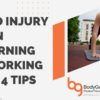Physical therapy at Body Gears corrects mechanical, neuromuscular, and motor control deficits that are perpetuating disc irritation. With proper management through conservative care, spinal discs can heal just like any other tissue in the body. Surgery is not necessarily the best or only option. This article debunks five myths on disc injury and healing.
Myth #1 – Discs can “slip” out of place.
It is nearly physically impossible for discs to slip out from in between the vertebrae. Discs are firmly attached by two thick ligaments called the anterior longitudinal ligament and the posterior longitudinal ligament. The disc also has a thick outer layer called the annulus fibrosis that attaches to the vertebrae above and below which protects the gelatinous inner layer called the nucleus pulposus.
Discs don’t slip – they herniate. The most common types of disc herniation are degeneration and protrusion, both of which are commonly treated by physical therapists at Body Gears. The four stages of disc herniation are listed below from least to most severe:
- Degeneration: The inner gelatinous center pushes into the outer annulus fibrosis.
- Protrusion: The annulus fibrosis forms a bulge or out-pouching that sometimes presses against nerves.
- Extrusion: The annulus fibrosis ruptures but the inner gelatinous center remains intact.
- Sequestration: The annulus fibrosis ruptures and the inner gelatinous center separates from the main part of the disc.
Myth #2 – Surgery is the best and only option.
A recent study revealed that spontaneous regression of disc injury can occur, and showed that disc injury can completely resolve with conservative care.1 Spontaneous regression occurs at a rate of 96% for disc sequestration, 70% for disc extrusion, 41% for disc protrusion, and 13% for disc bulging. Complete herniation resolution occurred in 43% of sequestered discs and 15% for extruded discs.1
Myth #3 – I will have permanent limitation or disability.
Individuals with disc injury fear that they will never be able to do the activities they once did, whether this is working in an intensive manual labor job, running, caring for loved ones, sitting comfortably, or simply bending their back. With patience and the right type of treatment, you can return to 100% prior level of function without pain.
Myth #4 – MRIs and imaging will show the cause of my back pain.
Advances in MRI imaging has enabled clinicians to identify minute changes in disc structure. However, just because the MRI showed a disc injury doesn’t mean that the injury is even the cause of your pain. A recent study on 1,211 healthy adults from the ages of 20’s to 70’s used MRI imaging and CT to examine disc aging. The study revealed that most people have disc degeneration, disc bulging, or disc protrusion without pain, with the percentage of disc abnormality increasing with age.2
Disc degeneration and bulging is a normal part of aging and should not be feared.

Myth #5 – Movement will make my disc injury worse.
With the professional guidance of a Body Gears Physical Therapist, exercise and movement can help your discs heal. Physical Therapists at Body Gears expertly facilitate disc healing by treating the mechanical, neuromuscular, and motor control causes of disc irritation. Hands-on soft tissue and joint mobilization reposition vertebrae and reduce soft tissue pull on discs so the back achieves proper alignment. Neuromuscular retraining of inhibited core and lumbar musculature muscularly stabilizes the lumbar spine to reduce the mechanical stress on spinal discs during movement. Extensive training in posture, bending, and lifting mechanics then enable the individual to fully return to life tasks.
References
- Chiu CC e. The probability of spontaneous regression of lumbar herniated disc: a systematic review. – PubMed – NCBI. Ncbinlmnihgov. 2016. Available at: http://www.ncbi.nlm.nih.gov/pubmed/25009200. Accessed February 19, 2016.
- 2. Brinjikji W e. Systematic literature review of imaging features of spinal degeneration in asymptomatic populations. – PubMed – NCBI. Ncbinlmnihgov. 2016. Available at: http://www.ncbi.nlm.nih.gov/pubmed/25430861. Accessed February 19, 2016.
Tags: body gears, physical therapy, body, back, disc, disc herniation, lower back, spine






